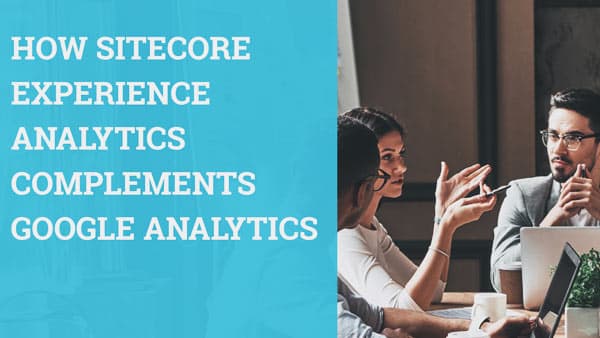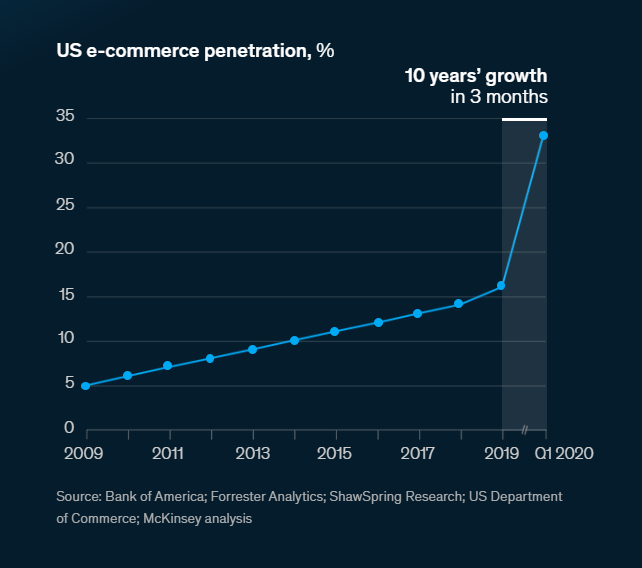

Nov 19, 2020
Over the past few years, ecommerce has matured to become the multibillion-dollar industry that it is today. In 2020, due to the pandemic, ecommerce reached an all-time high and according to Gartner, the shift consumers have done towards online shopping is likely to remain, evolving digital commerce in the post-pandemic years.
In fact, McKinsey stated that in just three months time, the ecommerce penetration in the US has grown more than it had in the past ten years.

But without a digital experience platform to guide them in the changing digital ecosystem, it’s just not possible for companies to make the most of the surge of ecommerce as the channel to capture the consumers’ attention. A headless DXP like Sitecore, that also doubles as an ecommerce solution, has all the features and capabilities an ecommerce store needs.
Let’s take a closer look at how Sitecore CMS’s headless architecture drives ecommerce growth and how its features can help you to build a profitable store.
What is Headless Ecommerce?
In a nutshell, the term headless describes a platform that has been architected to separate how content (in any form) is used, managed, and stored in the backend of the CMS. It means that content exists independently of the frontend or presentation layer, enabling marketers to push content across devices with ease.
The greatest benefit of the headless architecture is that when you create content, you create something that can be used across multiple platforms. With a DXP like Sitecore, you can display the same product information and photography on a mobile device, a mobile app, single page application or even have it read out loud by Siri.
For ecommerce, the headless approach enables richer user experiences based on JavaScript frameworks to enhance the UI. In a tightly coupled CMS, you’re more constrained in regard to what you can do with your content, but with the help of APIs, a headless ecommerce platform can connect these frameworks with the backend, enabling both to work in sync, but separately to deliver content faster.
How Sitecore’s Headless Architecture Improves Ecommerce Performance
Thanks to the headless architecture, marketers and developers can work together to design and build digital experiences and improve the buyer journey. Also, both the Sitecore Experience Platform and Sitecore Experience Commerce are built with extensibility in mind. This means that for ecommerce-related actions, there can be various API entry points fetching information or performing actions.
Whether it’s adding a product to your shopping cart, or going through the checkout process with different options of payment, or displaying different storefronts to different visitors, APIs and headless capabilities support the core functionality that makes ecommerce stores work.
Intro To Sitecore Experience Commerce
Sitecore Experience Commerce is built on top of Sitecore Experience Platform and enhances its content management capabilities with ecommerce-related tools and microservices.
Sitecore Experience Commerce helps marketers and content editors deliver content and guides users to take the next step in their customer journey. The platform combines data, content, and commerce to offer contextually relevant experiences to customers.
Marketers are provided with all they need to build and operate a global digital commerce storefront with personalized, one-on-one buying experiences that can be deployed with Kubernetes or Microsoft Azure both as PaaS, IaaS, or on-premise.
Benefits of Sitecore Experience Commerce
Here are some of the main benefits of Sitecore Experience Commerce for ecommerce stores.
Enhanced User Journeys
Sitecore Experience Commerce gives you the tools to build a contextual customer experience where all the steps a visitor has to take to convert are clearly defined and delineated. In Sitecore, you can use explicit data to target specific content to specific groups of visitors, enabling a more relevant and personalized experience across the user journey.
1-on-1 Personalization
Using Sitecore XC, marketers can automatically determine the visitor’s profile, either as someone that has visited already or as a best-fit persona, and track their actions. With its AI capabilities, Sitecore XC can deliver relevant content to users, including product recommendations, featured products, and promotions.
Better Testing Options
One of the advantages of Sitecore is that it supports testing to the fullest, With Sitecore XC, marketers can test fields, content, pages, and even entire digital experiences across user interactions. With A/B and multivariate testing, Sitecore enables total optimization as content gets added and updated. Also, the platform gives you the tools to review all your tests and optimizations at a glance and replicate the ones that are already working.
Contextual Shopping Experiences
Regardless of where they are shopping, consumers expect consistency and enjoyment. It doesn’t matter if they’re using a smartphone or a computer, a seamless, contextual experience is a must to move customers across the funnel. Sitecore XC is the platform that unifies the entire shopping experience and keeps it cohesive and seamless.
Commerce Connect API
Sitecore Commerce Connect is an API for storefront developers that integrates a frontend web shop solution with a backend commerce system. With the connect API, you can integrate Sitecore Commerce to any third party ecommerce platform as long as they have created a Sitecore Connect connector, which most ecommerce platforms have done. This enables users to apply the unique features of Sitecore in ecommerce regardless of the external commerce system being used.
Sitecore Commerce Connect also acts as an integration layer between a front-end web shop solution and a back-end external commerce system. The back-end system can be any ecommerce system for which Commerce Connect connectors have been created by Sitecore or a third-party vendor.
The Benefits of Implementing Sitecore With A Partner
Customers of today are all about the shopping experience. With a tool like Sitecore Commerce, capable of driving ecommerce growth using content, personalization, APIs, and marketing automation, you gain the toolbox to deliver memorable digital experiences before, during, and after the purchase.
However, we understand that it might be daunting to jump into the waters of Sitecore, especially if you’re migrating from another CMS or DXP.
At Oshyn, we have a tried and tested process for helping people who want to make the most of their ecommerce experience. Our unique approach and our partnership with Sitecore makes us well-suited to help you build and design a robust ecommerce store into Sitecore.
Our team can guide you through the thick and thin of configuring an ecommerce store and leave you with a well-oiled, ready to go commerce platform that will drive your brand’s growth.







